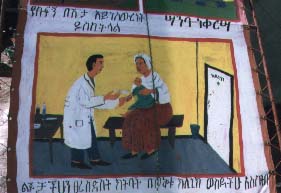|
|
[The circuses] |
[Homebase]
[Gallery] |
[Festival]
[Ethiopian Press] |
[Partners]
[Activity Report] |
|
|
Circus in Ethiopia, the association, includes children from all social
levels from kids living on the street to the more well off younger of teachers.
This makes it, fascinating. Those already performing on tour teach those
living in the street. The older youths instruct the children who have recently
joined. There is no difference, it doesn't matter where you come from or
which religion you believe in.
In the European media, the Circus was often reduced to a mere street-children‘s
project. Circus in Ethiopia doesn't want their country to be linked with
pictures of hunger and poverty but with joy and creativity.
The dream of Circus in Ethiopia is now to build up an institution in
which they can live and learn. All the benefits of 1998 tour will go to
finance this homebase in four cities.
Today more than ever, The Circus needs money and partners.
Circus in Ethiopia is actively looking for funding agencies interested
in assisting the development and establishment of the organisation. We
are requesting assistance to fund programs for a limited period to allow
the establishment of the final structures of the organisation in view of
financial independence by the year 2003.

Circus Ethiopia in Addis Ababa's main square, Meskal Square, January 1998 |
Here are the main objectives of Circus in Ethiopia:
| «Cirque
du soleil» has influenced the spiritual development of the Ethiopian
circuses since their first involvement in 1991. Through videos of its performances
and music recordings this Canadian circus has set a standard of excellence
against which the Ethiopians children and the trainers have developed their
dreams of circus with an identity of its own.
Since 1993 the «Cirque du Soleil» team in Montreal has donated shipments of costumes and sound equipment to support their effort. Last year a performance by «Cirque du soleil» was held in Washington to raise funds for Circus in Ethiopia. A large sound system was purchased with the revenue of the performance to reach the 3000 and more crowds which become common in Addis Ababa. Others fund raising performances are due to be held in 1998. The funds raised will be used to purchase gymnastics equipment. Costumes and acrobatics equipment will also be included in the consignment by «Cirque du Soleil». |

| Circus in Ethiopia and The Red Cross have been
partners since 1995. The international committee of The red Cross, The
Ethiopian Red Cross Society and the International Federation of Red Cross
and Red Crescent Societies have been developing dissemination programs
through the free performances of the circuses.
Red Cross principles such as the Principle of Humanity are relayed to the large audiences of the circuses through small plays in between musical programs or directly through Circus theatre performances. Many or the circuses' performances are organised in local stadiums with the co-operation of Ethiopian Red Cross branches across Ethiopia. Theses events are a powerful means for the Red Cross to make its work and services known to the population.
|

| The United Nations Children's fund is well known
for its life saving work for children around the world.
Unicef has been Circus in Ethiopia main partner since 1995, with significant funding from the Neerderlands Committee for Unicef, for an initial period for three years. According to Unicef Circus in Ethiopia provides a unique platform for raising public awareness in children's right while helping to develop the potential of some of Ethiopian's most disadvantaged children. In collaboration with the Unicef Office in Ethiopia and the Children and Youth Affairs Organisation of the Ethiopia government a strategy was designed to increase the potential of the four circuses to disseminate vital health information to the population at large immunisation, control of diarrhoea diseases and AIDS prevention where chosen as the focus of the advocacy work of the circuses. |
| Radda Barnen had been active in providing services
and advocating for children's rights in Ethiopia for the last twenty years.
Radda barnen was the organisation to understand the objective of circus
for Ethiopians children. Since 1992 its funding and advice have allowed
the circus to grow in an substantial way. For the first three years its
funding covered all training and performing expenses. The Radda Barnen
team provided precious advice on laying down the basic structures of the
organisations.
Radda Barnen is part of the Save the Children movement. Their work in Ethiopia deals with projects which promote the lives of children across the country. From emergency support to Sudanese children, who have escaped from war and sheltered in refugee camps on The border of Ethiopia, to shelters for street children as well as to promoting theatre resources as advocacy methods, the organisations works in Partnership with local initatives, people helping themselves. |
| Oxfam started its work in Ethiopia in 1974. The
1984-85 famine dramatically increased Oxfam's work in the country. Since
then it has replaced its emergency relief operations by sustainable development
projects.
Its involvement with Circus in Ethiopia is recent and focuses on the impact the performances and the circus training has on the community, as an agent of social change. The advocacy messages are of great importance, but the grass roots, community based aspect of Circus Ethiopia, is also of prime interest for Oxfam. The circus is seen as powerful motor and means of expression for participating children but also for the entire community. Oxfam works in Ethiopia both as a funding and operational NGO. Oxfam's strategic aims are:
http://www.antenna.nl/novib/ |
| Based in the Netherlands, Novib is a member of
the Oxfam Family. ...
|